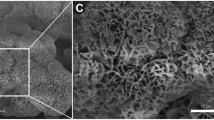Abstract
Introduction
lt was the purpose of this study to investigate how bone morphogenetic protein 2 (BMP-2) influences remodelling and the biomechanics of solvent-dehydrated bone in the long run. Furthermore, the early influence of this growth factor on the substitute was investigated.
Materials and methods
Using a weight-bearing animal model, solvent-dehydrated bone was implanted in the tibial head of merino sheep (n=12) after being loaded with BMP-2 (100 μg/100 μl). At 4 weeks (n=6) and 9 months (n=6) after surgery, histomorphological, histomorphometrical and biomechanical investigations were performed.
Results
At 9 months after implantation of BMP-2-loaded specimens, the bone per tissue volume was high, with levels above those of physiological cancellous bone. The amount of remaining solvent-dehydrated bone was markedly decreased, and in contrast, the amount of newly formed bone was extremely high. The specimen degradation had already occurred within the first 4 weeks after implantation, showing no further impact throughout the 9-month period. Biomechanical investigations at 9 months after implantation demonstrated a yield strength which achieved levels at least equivalent to physiological cancellous bone. BMP-2 showed no significant impact on the biomechanical properties after 4 weeks, compared to specimens prior to implantation.
Conclusion
BMP-2 predominantly has an impact on the early implant degradation as well as bone formation, which leads to an almost completed bone remodelling of the solvent-dehydrated specimen within the study period of 9 months.




Similar content being viewed by others
References
Agrawal CM, Best J, Boyan BD, Heckman JD (1994) Protein release kinetics of biodegradable implants used for delivering BMP to fracture non-unions. The 20th Annual Meeting of the Society for Biomaterials, Boston, USA, p 95
Baylink DJ, Finkelmann RD, Mohan S (1993) Growth factors to stimulate bone formation. J Bone Miner Res 8:565–572
Bostrom M, Lane JM, Berberian WB, Missri AA, Tomin E, Weiland A, Doty SB, Glaser D, Rosen VM (1995) lmmunolocalization and expression of bone morphogenetic proteins 2 and 4 in fracture healing. J Orthop Res 13:357–363
Boyne PJ (2001) Application of bone morphogenetic proteins in the treatment of clinical oral and maxillofacial osseous defects. J Bone Joint Surg Am 83 [Suppl 1]:146–150
Damien CJ, Parsons R (1991) Bone graft and bone graft substitutes: a review of current technology and applications. J Appl Biomater 2:187–208
Guicheux J, Kimakhe S, Heymann D, Pilet P, Daculsi G (1998) Growth hormone stimulates the degradation of calcium phosphate biomaterial by human monocytes macrophages in vitro. J Biomet Mater Res 49:79–85
Ignatius A, Unterricker K, Wenger K, Richter M, Lohse P, Hirst H, Claes L (1997) A new composite made of polyurethane and glass ceramic in a loaded implant model: a biomechanical and histological analysis. J Mater Sci Mater Med 8:753–756
Kessler S, Kastler S, Mayr-Wohlfart U, PuhI W, Günther KP (2000) Stimulation primärer Osteoblastenkulturen mit rh-TGF-beta, rh-bFGF, rh-BMP 2 and rx-BMP 4 in einem in-vitro Modell. Orthopäde 29:107–111
Kessler S, Mayr-Wohlfart U, Ignatius A, PuhI W, Claes L, Günther KP (2001) Solvent dehydrated bone transplants to bridge segmental bone defects: histomorphological and biomechanical investigations in an animal model. Arch Orthop Trauma Surg 121:472–475
Kessler S, Mayr-Wohlfart U, lgnatius A, PuhI W, Claes L, Günther KP (2002) Histomorphological, histomorphometrical and biomechanical analysis of ceramic bone substitutes in a weight-bearing animal model. J Mater Sci Mater Med 13:191–195
Kubler NR, Reuther JF, Faller G, Kirchner T, Ruppert R, Sebald W (1998) lnductive properties of recombinant human BMP-2 produced in a bacterial expression system. lnt J Oral Maxillofac Surg 27:305–309
Macewen W (1881) Observations concerning transplantation on bone. Proc R Soc Lond 32:232–235
Mayr-Wohlfart U, Kessler S, PuhI W, Gunther KP, Knöchel W (2001) BMP4 of Xenopus laevis stimulates differentiation of human primary osteoblast-like cells. J Bone Joint Surg Br 83:144–147
Mundy GR (1996) Regulation of bone formation by bone morphogenetic proteins and other growth factors. Clin Orthop 323:24–28
Reddi AH (1998) Role of morphogenetic proteins in skeletal tissue engineering and regeneration. Nat Biotech 16:247–252
Salama R, Gazit E (1978) The antigenicity of Kiel bone in the human host. J Bone Joint Surg Br 60:262–265
Urist MR (1965) Bone: formation by autoinduction. Science 150:893–899
Winet H, Bao JY (1998) Fibroblast growth factor-2 alters the effect of eroding polylactide-polyglycolide on osteogenesis in the bone chamber. J Biomed Mater Res 40:567–576
Wozney JM, Rosen V (1998) Bone morphogenetic protein and bone morphogenetic gene family in bone formation and repair. Clin Orthop 346:26–37
Yasko AW, Lane JM, Fellinger EF, Rosen V, Wozney JM, Wang EA (1992) The healing of segmental bone defects, induced by recombinant human bone morphogenetic protein (rhBMP-2). A radiographic, histological and biomechanical study in rats. J Bone Joint Surg Am 74:659–670
Acknowledgements
This study was supported by Tutogen Medical, Neunkirchen, Germany. The experiments of this investigation comply with national guidelines and regulations for the care and use of animals. It was approved by the German authorities (Regierungspräsidium Tübingen, Germany).
Author information
Authors and Affiliations
Corresponding author
Rights and permissions
About this article
Cite this article
Kessler, S., Koepp, H.E., Mayr-Wohlfart, U. et al. Bone morphogenetic protein 2 accelerates osteointegration and remodelling of solvent-dehydrated bone substitutes. Arch Orthop Trauma Surg 124, 410–414 (2004). https://doi.org/10.1007/s00402-004-0696-z
Received:
Published:
Issue Date:
DOI: https://doi.org/10.1007/s00402-004-0696-z




